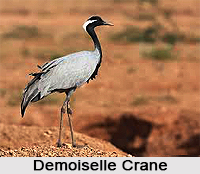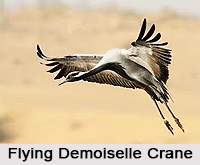 Demoiselle Crane is an Indian Bird concentrated in Central Asian countries and migrates in winter in the Asian countries like India, Pakistan, Bangladesh and Thailand.
Demoiselle Crane is an Indian Bird concentrated in Central Asian countries and migrates in winter in the Asian countries like India, Pakistan, Bangladesh and Thailand.
Demoiselle Crane bears the scientific name of "Anthropoides virgo". Demoiselle crane is a species of crane found in central Eurasia, ranging from the Black Sea to Mongolia and North Eastern China.
Mythological Significance of Demoiselle Crane
The flying formation of Demoiselle Crane or Knooj during migrations from Central Asian countries like Turkey also inspired infantry formations in ancient India. In Mahabharata, the migration of Demoiselle crane describes both warring sides adopting the koonj or Demoiselle crane formation on the second day of the Kurukshetra War in the final episode of Mahabharata.
Breeding of Demoiselle Crane
There is also a small breeding population of Demoiselle crane in Turkey and its adjacent countries. These cranes are migratory birds.
Migration of Demoiselle Crane
Demoiselle Crane from western Eurasia will spend the winter in Africa whilst the birds from Asia, Mongolia and China will spend the winter in the Indian subcontinent. The bird is symbolically significant in the culture of North India, where it is known as the "Koonj".
Structure of Demoiselle Crane
Demoiselle crane is about 85-100 cm long, 76 cm tall and has a 155-180 cm wingspan. It weighs 2-3 kg. It is the smallest species of crane in the crane family.
Size of Demoiselle Crane
Demoiselle Crane is slightly smaller than the common crane but has similar plumage. It has a long white neck stripe and black on the fore neck extends down over the chest in a plume. Demoiselle crane has a loud trumpeting call, higher-pitched than the common crane. Like other cranes it has a dancing display, more balletic than the common crane, with less leaping.
Concentration of Demoiselle Crane
Demoiselle Crane lives in a variety of different environments, including desert areas and numerous types of grasslands like the flooded, mountain, temperate and tropical grassland, which are often within a few hundred metres of streams or lakes. However, when nesting, they prefer patchy areas of vegetation which is tall enough to conceal them and their nests, yet short enough to allow them look out for predators whilst incubating their eggs.
Toughest Migration of the World
Demoiselle Cranes have to take one of the toughest migrations in the world. In late August through September, Demoiselle cranes gather in flocks of up to 400 individuals and prepare for their flight to their winter range. During their migratory flight south, demoiselles fly like all cranes, with their head and neck straight forward and their feet and legs straight behind, reaching altitudes of 16,000-26,000 feet. Along their arduous journey they have to cross the Himalayan Mountain Range to get to their over-wintering grounds in India.
 Behaviour of Demoiselle Crane
Behaviour of Demoiselle Crane
Demoiselle Cranes, while migrating die from fatigue, hunger and predation from golden eagles. Simpler, the lower routes of Demoiselle crane are possible, such as crossing the range via the Khyber Pass, which is located in Pakistan. However, their presently preferred route has been hard-wired by countless cycles of migration. At their wintering grounds, demoiselles have been observed flocking with common cranes, their combined totals reaching up to 20,000 individuals. Demoiselle crane maintains separate social groups within the larger flock. In March and April, Demoiselle cranes begin their long spring journey back to their northern nesting grounds.
Decline of Popuylation of Demoiselle Crane
Demoiselle cranes when migrated in India are often slaughtered for their meat. In Khichan region of Rajasthan, the villagers feed the cranes on their migration and these large congregations have become an annual spectacle.
Demoiselle Crane in IUCN Red List of Threatened Species
Demoiselle crane is evaluated as Least Concern on the IUCN Red List of Threatened Species. It is one of the species to which the Agreement on the Conservation of African-Eurasian Migratory Waterbirds applies.



















